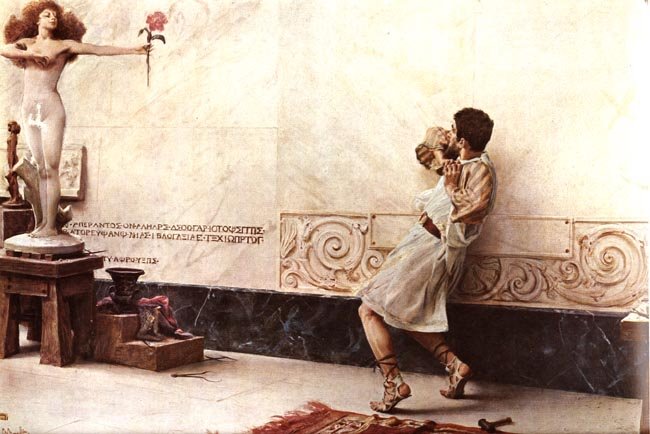



Ha ha! This is published -once more- on request!
Four BIG Alma Tadema's for your viewing pleasure (clik to enlarge) and -as always- against the
Mafia degli scarabocchi :-)
And a long list of all (?) his paintings...
Here you are, gentlemen and gentles-ladies with four BIG (click on them) insuperable paintings:
A Favourite custom
A Silent Greeting
Silver favourites (a very famous one)
God Speed
Enjoy!
Note that Alma Tadema was a 'ridller': "
time and again the seeming innocence of the scenes he depicts is subverted by a mischievously placed inscription or statue, suggesting to the initiated a darker and usually risque meaning".
A list of Alma's paintings (found
here)...
A Bath (An Antique Custom), 1876
A Birth Chamber, Seventeenth Century, 1868
A Coign Of Vantage, 1895 (one of Alma-Tadema's most famous works)
A Collection of Pictures At The Time Of Augustus, 1867
A Declaration, 1883
A Dedication To Bacchus, 1889
A Difference Of Opinion, 1896
A Family Group, 1896
A Favourite Custom, 1909
A Female Figure Resting (date required, Op. 243 - also known as Dolce Far Niente)
A Greek Woman, 1869
A Harvest Festival, 1880 (also known as A Dancing Bacchante At Harvest Time)
A Hearty Welcome, 1878
A Kiss, 1891
A Listener, 1899
A Picture Gallery, 1866
A Prize For The Artists' Corp (Wine), (date required)
A Pyrrhic Dance, 1869
A Reading From Homer, 1885
A Roman Art Lover, 1870
A Roman Emperor, AD 41, 1871
A Roman Scribe Writing Dispatches, (date required)
A Sculptor's Model, 1877 (also known as Venus Esquilina)
A Sculpture Gallery, 1867
A Silent Greeting, 1889
A Street Altar, 1883
A Votive Offering, 1873
A World Of Their Own, 1905
After The Audience, 1879
Agrippina With The Ashes Of Germanicus, (date required, Op. 307)
Always Welcome, 1887
An Audience, (date required)
An Earthly Paradise, 1891
An Exedra, 1869
An Oleander, 1882
Antony And Cleopatra, 1883
Architecture In Ancient Rome, 1877
Ask Me No More, 1896
Autumn, Vintage Festival, 1877
Ave, Caesar! Io, Saturnalia!, 1880
Bacchanale, 1871
Between Hope And Fear, 1876
Between Venus And Bacchus, 1882
Boating, 1868
Carcalla, 1902
Caracalla And Geta, 1909
Catullus At Lesbia's, 1865
Cherries, 1873
Comparisons, 1892
Confidences, 1869
Courtship, (date required)
Courtship - The Proposal, 1892
Death Of The Pharoah's Firstborn Son, 1872
Drawing Room, Holland Park, 1887
Dolce Far Niente, 1882 (Oil on panel version)
Egyptian Chess Players, 1865
Egyptian Juggler, 1870
Entrance To A Roman Theatre, 1866
Exhausted Maenides After The Dance, c.1873-1874
Expectations, 1885
Faust And Marguerite, 1857
Flag Of Truce, 1900 (op. 358, signed Artist's War Fund 1900)
Flora, 1877 (also known as Spring In The Gardens Of The Villa Borghese)
From An Absent One, 1871
Gallo-Roman Women, 1865
God Speed!, 1893
Golden Hour, 1897
Hadrian Visiting A Romano-British Pottery, 1884
Hero, 1898
Hopeful, 1909
In My Studio, 1893
In The Peristyle, 1866
In The Tepidarium, 1881
In The Temple, 1871
In The Time Of Constantine, 1878
Interior Of Caius Martius's House, 1901
Interior Of The Church Of San Clemente, Rome, 1863
Interrupted, 1880
Joseph, Overseer Of The Pharoah's Granaries, 1874
Leaving Church In The Fifteenth Century, 1864
Lesbia Weeping Over A Sparrow, 1866
Love's Jewelled Fetter, 1895
Love's Votaries, 1891
Maria Magdalena, 1854
Master John Parsons Millet, 1889
Maurice Sens, 1896
Midday Slumbers, (date required)
Miss Alice Lewis, 1884
Mrs Frank D. Millet, 1886
Mrs George Lewis And Her Daughter Elizabeth, 1899
My Studio, 1867
Ninety-Four In The Shade, 1876
Not At Home, 1879
On The Road To The Temple Of Ceres, 1879
Pandora, 1881
Pastimes In Ancient Egypt, 3,000 Years Ago, 1863
Phidias Showing The Frieze Of The Parthenon To His Friends, 1868
Pleading, 1876
Poetry, 1879
Portrait Of A Woman, 1902
Portrait Of Aime-Jules Dalou, His Wife And Daughter, 1876
Portrait Of Anna Alma-Tadema, 1883
Portrait Of Ignacy Jan Paderewski, 1891
Portrait Of Miss Laura Theresa Epps (Lady Alma-Tadema) (date required)
Portrait Of Mrs Charles Wyllie, (date required)
Portrait Of The Singer George Henschel, 1879
Pottery Painting, 1871
Preparation In The Coliseum, 1912 (Op. 408)
Preparations For The Festivities, 1866
Proclaiming Claudius Emperor, 1867
Promises Of Spring, 1890
Prose, 1879
Resting, 1882
Sappho And Alcaeus, 1881
Sculptors In Ancient Rome, 1877
Self Portrait, 1852
Self Portrait, 1896
Shy (date required, Op. 249)
Silver Favourites, 1903
Spring, 1894
Spring Flowers, (date required)
Strigils And Sponges, 1879
Summer Offering, 1911 (also known as Young Girl With Roses)
Sunshine, (date required)
Tarquinius Superbus, 1867
The Baths Of Caracalla, 1899
The Colosseum, 1986
The Conversion Of Paula By Saint Jerome, 1898
The Crossing Of The River Berizina -1812, c.1859-1869
The Death Of Hippolytus, 1860
The Drawing Room At Townshend House, 1885
The Discourse, (date required)
The Education Of The Children Of Clovis, 1861
The Epps Family Screen, 1870-1871
The Favourite Poet, 1888
The Finding Of Moses, 1904
The Flower Market, 1868
The Frigidarium, 1890
The Honeymoon, 1868
The Massacre Of The Monks Of Tamond, 1855
The Parting Kiss, 1882
The Picture Gallery, 1874
The Roman Potter, 1884
The Roman Wine Tasters, 1861
The Roses Of Heliogabalus, 1888 (Op. 283)
The Sculpture Gallery, 1874
The Siesta, 1868
The Soldier Of Marathon (Oil on panel version) (date required, Op. 300)
The Soldier Of Marathon (Oil on canvas version, date required)
The Triumph Of Titus, 1885
The Vintage Festival, 1870
The Voice Of Spring, 1910
The Way To The Temple, 1882
The Women Of Amphissa, 1887
The Year's At The Spring, All's Right With The World, 1902
This Is Our Corner, 1873 (also known as Laurense And Anna Alma-Tadema)
Thou Rose Of All The Roses, 1883
Tibullus At Delia's, 1866
Unconscious Rivals, 1893
Under The Roof Of Blue Ionian Weather, 1903
Unwelcome Confidences, 1902
Vain Courtship, 1900
Venantius Fortunatus Reading His Poems To Radegonda VI, 1862
Water Pets, (date required)
Welcome Footsteps, 1883
When Flowers Return, 1911
Whispering Noon, 1896
Who Is It?, 1884
Xanthe And Phaon, 1883













.jpg)
















